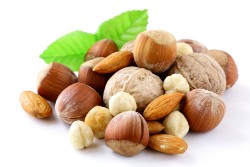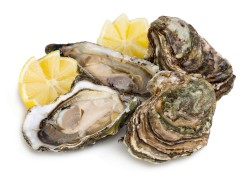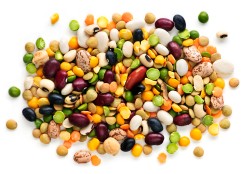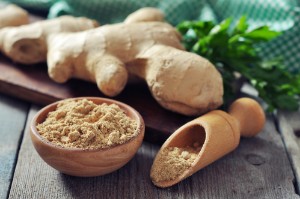What's Good for Strengthening Bones – The 7 Best Foods according to Research
 Bones create a strong frame that helps to move in space and protects the internal organs of a person from any external damage.
Bones create a strong frame that helps to move in space and protects the internal organs of a person from any external damage.
Unfortunately, even such a robust system can fail. Throughout life, the chemical composition, as well as the strength of bone tissue, are prone to change. These parameters are influenced by a large number of factors: from aging and the number of fractures to nutritional deficiencies in the body.
Due to an incorrect diet and an incorrect lifestyle, multiple disorders of the musculoskeletal system can occur, which can significantly limit a person's daily activity.
Having studied the research available today, we can highlight a list of 7 useful products, the use of which will strengthen bones, reduce the risk of osteoporosis and maintain the health of the entire musculoskeletal system.
1. Pumpkin Seeds
 All plant seeds contain huge amounts of calcium and magnesium (and as you know, up to 50% of this mineral is located in the bone depot).
All plant seeds contain huge amounts of calcium and magnesium (and as you know, up to 50% of this mineral is located in the bone depot).
Pumpkin seeds are the most useful.
One of the scientific studies confirmed that pumpkin seeds help to increase the number of osteoblasts and reduce the crowding of osteoclasts in bone tissue, which provides reliable prevention of osteoporosis and restores the strength of the skeleton.
They should definitely be consumed by pregnant and lactating women in order to prevent osteoporosis (decrease in bone density), as well as children for active bone growth and teething.
The daily norm of magnesium is about 400-420 mg for men and about 300-320 mg for women. Children under 14 years of age need from 80 to 240 mg of magnesium. At the same time, 100 g of pumpkin seeds contain almost 600 mg of macronutrient, which completely covers the daily requirement of the body.
2. Nuts
 Nuts are a universal source of magnesium, alpha-linoleic acid and omega-3 fatty acids, which not only reduce the rate of physiological destruction of bone tissue, but also contribute to the rapid restoration of damage and bone fusion (fractures, dystrophic diseases).
Nuts are a universal source of magnesium, alpha-linoleic acid and omega-3 fatty acids, which not only reduce the rate of physiological destruction of bone tissue, but also contribute to the rapid restoration of damage and bone fusion (fractures, dystrophic diseases).
Lots of research showed high efficiency of nuts. For example, Canadian scientists have concluded that a "healthy" eating behavior with the mandatory inclusion of nuts in the diet improves the mineral composition of bone tissue and significantly reduces the risk of osteoporosis and fractures.
Australian Scientists came to a similar result. According to their data, the consumption of plant foods (with the addition of vegetables, legumes, fruits and nuts) increases the strength of bone tissue, prevents the appearance of dystrophic and degenerative diseases from the striated musculature.
3. Leafy greens
 All green leafy plants are rich in valuable proteins and trace elements. They are especially appreciated for the presence of magnesium, calcium and vitamin K. At the same time, the most useful are cilantro, lettuce and green onions (feather).
All green leafy plants are rich in valuable proteins and trace elements. They are especially appreciated for the presence of magnesium, calcium and vitamin K. At the same time, the most useful are cilantro, lettuce and green onions (feather).
About 30-80 g of the described products provide the daily need for vitamin K. This vitamin increases the rate of bone regeneration due to the activation of osteocalcitonin.
Proven that vitamin K deficiency in the blood increases the risk of hip fracture by almost 30%. Similar results were obtained by Japanese scientists , however, the degree of risk was slightly lower – 21%.
4. Fatty fish varieties
 Oily fish is rich in vitamin D. Most of it is found in tuna, mackerel, salmon, sardines, mackerel.
Oily fish is rich in vitamin D. Most of it is found in tuna, mackerel, salmon, sardines, mackerel.
Vitamin D plays a major role in maintaining the integrity of bone tissue, and also helps to absorb calcium. With vitamin D deficiency, there is a gradual decrease in bone strength, and the risk of fractures increases.
Daily value of vitamin D, according to the U.S. Department of Health , for an adult – about 600 IU, older people should raise the bar to 800 IU. Surprisingly, only 150-180 g of "average" fish provides this physiological need.
Fish also contains valuable omega-3 fatty acids and vitamin A, which are regulators of ion metabolism in bone tissue.
In addition, oily fish is one of the 11 Foods Most beneficial for Joints and Cartilage .
5. Cheese
 Hard cheeses (Gouda, Cheddar, Parmesan) have a large set of useful properties, which contain 10-14 times more calcium than regular milk.
Hard cheeses (Gouda, Cheddar, Parmesan) have a large set of useful properties, which contain 10-14 times more calcium than regular milk.
The specialists of the University of Granada claim that calcium normalizes metabolic processes in bone tissue, prevents resorption, and also improves the functioning of the entire musculoskeletal system. The amount of calcium in the diet is inversely proportional to the frequency of osteoporosis, oncological and cardiological diseases.
The World Health Organization recommends that an adult consume at least 6,500 g of cheese and products with its use per year.
6. Shellfish
 Shellfish, as well as some other seafood, provide the body with valuable amino acids, a variety of vitamins, macro- and microelements. However, the most important are the B vitamins.
Shellfish, as well as some other seafood, provide the body with valuable amino acids, a variety of vitamins, macro- and microelements. However, the most important are the B vitamins.
Vitamin B12, according to the US Department of Health , normalizes the metabolism of mineral salts at the level of bone tissue, reduces the risk of manifestation of osteoporosis.
7. Beans and soybeans
 Beans contains a significant amount of protein, starch, vitamins (A, B, C, K, PP, K) and mineral components. According to the qualitative composition, the beans practically correspond to the meat of cattle.
Beans contains a significant amount of protein, starch, vitamins (A, B, C, K, PP, K) and mineral components. According to the qualitative composition, the beans practically correspond to the meat of cattle.
Soy gives the body natural isoflavonoids, lecithin, phytic acids. Such a set of useful substances creates prerequisites for the proper development of bones in young children, and also helps to prevent age-related decrease in bone density in the elderly.
Experiments on rats show that the consumption of soybeans inhibits bone resorption, prevents the development of osteoporosis in the perimenopausal period.
5 More Important Nutrition Tips
 To increase the strength of bone tissue and prevent various pathologies, it is recommended to follow the following recommendations:
To increase the strength of bone tissue and prevent various pathologies, it is recommended to follow the following recommendations:
- Balance your diet. A balanced diet and the absence of energy surpluses create the prerequisites for obtaining all the necessary nutrients (primarily proteins and carbohydrates), and are also effective in preventing obesity. Excessive stress on the musculoskeletal system significantly increases the risk of damage not only to joints and cartilage, but also to bones. Components such as vitamins (A, K, D, B12), magnesium, and calcium are especially important.
- Follow a fractional diet. It is recommended to take food 4-6 times a day in equal portions to create an even load on the metabolism in the body.
- Fry less. Frying or prolonged heat treatment by other methods destroys a lot of useful substances.
- Give up alcohol. Multiple scientific studies and experiments show that alcohol consumption (especially long-term) reduces bone density and contributes to the appearance of fractures. There was also a deterioration in the quality of all structural elements of the teeth. In addition, it is known that alcohol harms joints .
- Eat more fresh vegetables and fruits, leafy greens. These products saturate the human body with essential trace elements and vitamins, have a pronounced positive effect on metabolism.
Recommendations for lifestyle changes
 The state of bone tissue health is influenced not only by nutrition, but also by the nature of everyday behavior. It is important to follow the following recommendations:
The state of bone tissue health is influenced not only by nutrition, but also by the nature of everyday behavior. It is important to follow the following recommendations:
- Regular physical activity. Exercises strengthen the ligamentous apparatus and striated muscles. As a result, prerequisites are created for the adequate development of bone tissue. According to scientists , strength exercises are especially effective.
- Frequent outdoor activities. This helps to improve the supply of oxygen to all organs and tissues, and the prevention of microcirculatory disorders in the bones. Additionally, due to the sun's rays, you can get vitamin D. You should stay under ultraviolet light for no more than 30 minutes a day, and choose park areas as a place.
- A competent attitude to your health. Any foci of painful sensations or impaired mobility in the joint area, especially for a long time, should be a reason to urgently consult a specialist. Early initiation of treatment is much more likely to lead to positive results.
- Quitting smoking. Regular inhalation of tobacco smoke (including passive) has a negative effect not only on the condition of the musculoskeletal system, but also on the whole body. Vitamin D metabolism and vitamin C absorption are disrupted, and the synthesis of new collagen fibers is suppressed.
Conclusion
Thus, in order to preserve bone tissue health and prevent diseases, it is enough to adhere to proper nutrition, lead a healthy lifestyle with complete rejection of bad habits, and also consult a doctor in a timely manner if any pathological changes are detected. These rules will help to keep the musculoskeletal system in a healthy state.





